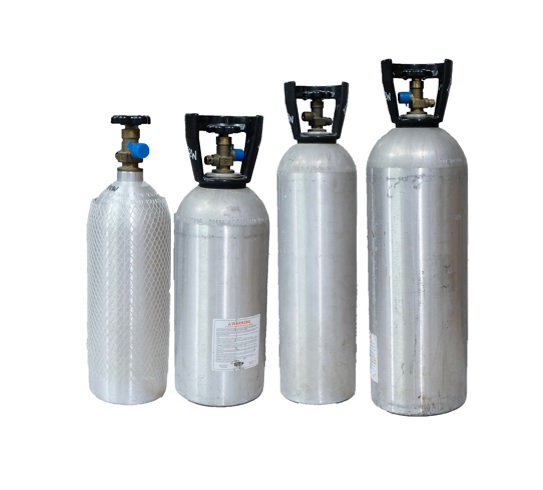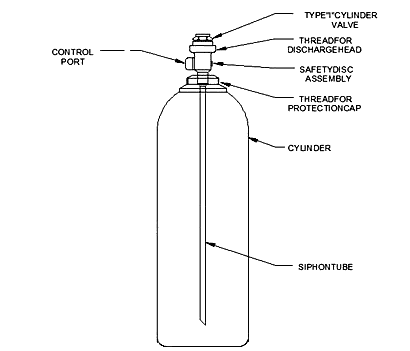CO2 Cylinder Tank
CO2 tanks come in a range of CO2 cylinder sizes and volumes; from a basic 5lb co2 tank all the way up to a large 50lb co2 tanks. They are designed to contain CO2, a colorless but not odorless gas, consisting of one part carbon and two parts oxygen. At ordinary temperatures, carbon dioxide is relatively unreactive; above 1,700 °C (3,100 °F), it partially decomposes into carbon monoxide and oxygen. Unlike most standard gases, the content of a CO2 cylinder is in a liquid form because, just like propane, it is liquefied under pressure. These tanks should always be stored or used in the upright position.
- CO2 cylinder pressure is approx. 860 psi.
This is most commonly a siphon design, whereas there is a long straw / tube going down the center to allow the liquid to enter and move up and out. This siphon dip tube is what draws the liquid CO2 supply from the cylinder.
construction
Typical CO2 tank cylinders used for various purposes such as carbonation in beverages, firefighting, or industrial applications are often constructed out of aluminum. Aluminum is favored for CO2 cylinders due to its lightweight nature, corrosion resistance, and ability to withstand high pressures. Additionally, aluminum cylinders are generally more affordable and easier to manufacture compared to other materials such as steel or composite materials.
Some CO2 cylinders are constructed using composite materials, such as fiberglass-wrapped aluminum or carbon fiber. These cylinders offer a combination of lightweight construction and high strength. Composite cylinders are often used in applications where weight reduction is critical, such as portable or aerospace applications.
Steel and stainless steel CO2 cylinders too exist. Steel cylinders are commonly used for storing compressed gases, including CO2. While less common than carbon steel cylinders, stainless steel cylinders are sometimes used for storing CO2, especially in industrial or corrosive environments. Stainless steel cylinders are highly durable and resistant to corrosion, making them suitable for long term use in harsh conditions.
intended use
A common pressure rating for aluminum CO2 storage tanks is around 1800 psi which allows the tank to safely contain carbon dioxide gas under typical storage conditions. However, the specific pressure rating can vary depending on factors such as the tank's size, design, and intended use. Pressure ratings for CO2 cylinder tanks are regulated by industry standards and safety regulations to ensure their safe operation. These standards dictate the minimum design requirements, including materials, thicknesses, and safety features, to withstand the pressures associated with storing compressed gases.
When selecting or using an aluminum CO2 storage tank, it's essential to adhere to the manufacturer's specifications and recommendations regarding pressure ratings, maintenance, and safety precautions. Additionally, regular inspection and testing of the tank's integrity are necessary to ensure safe and reliable operation over time.
Beverage Carbonation is probably the most common use of CO2 tank cylinders followed by their use in welding. CO2 is often used as a shielding gas in welding and metal fabrication processes. It helps to protect the weld area from atmospheric contamination, resulting in cleaner and stronger welds. CO2 cylinders are frequently used in MIG (metal inert gas) welding applications.
The safety and health industry also makes use of CO2 tanks. CO2 cylinders are utilized in fire suppression systems. They are also used in medical and healthcare applications, such as providing carbon dioxide for medical procedures, respiratory therapy, and anesthesia. They are also used in laboratory settings for research and experimentation.
Further down the list you will find CO2 tanks being utilized for refrigeration. CO2 is increasingly being used as a refrigerant in refrigeration and cooling systems due to its low environmental impact and energy efficiency. There are many other and less common uses across a number of industries from food processing to industrial manufacturing.
alternative uses
Information presented under alternative uses includes factual data and some conjecture including assessments about possible risks. It is neither suggested nor recommended that a CO2 tank cylinder be used for any purpose other than the intended design. An exploration of "what would" or "what could" happen is only theoretical for the purposes of thought and discussion. This web resources nor any of the contributors shall be held liable for what a reader may attempt to do. Do not try this at home.
People will ask if a CO2 cylinder can be repurposed. Some have questioned if such a cylinder can be used as a tank to store compressed air. Others have asked about storing other gasses in such a tank, even propane, which is a highly flammable gas that is stored in pressurized liquid form. Repurposing CO2 cylinders for storing other gases requires careful consideration of factors such as cylinder material, previous contents, and compatibility with the intended gas.
As compared to other types of tanks, specifically, for example, a propane tank: CO2 cylinders have much thicker walls than propane cylinders. Propane cylinders are 250 p.s.i. max pressure, CO2 cylinders are normally 1800 p.s.i. At 100 degrees F. propane exerts about 170 p.s.i., while CO2 exerts about 1400 p.s.i. Even at room temperature a full CO2 cylinders runs about 850 p.s.i. A typical air compressor won't reach much above 120-150 psi.
Unlike propane (C3H8) storage tanks, the CO2 tank lacks safety mechanisms for dealing with flammable gas and excess pressure buildup. CO2 cylinders are typically designed and manufactured to withstand the pressure and properties of carbon dioxide and composed of material that is non-reactive with CO2. Again, as an example, Propane could potentially react with the materials used in the construction of the CO2 cylinder, leading to corrosion, degradation, or even rupture of the cylinder.
It has been discussed where people have repurposed CO2 tank cylinders for C3H8 use on propane powered vehicles. They claim that after thorough cleaning and refurbishment of the cylinders that they can be used for storage of liquid propane. The source does not specifically discuss the CO2 tank construction material. Further research is required to learn if the material used to construct a CO2 tank can safely contain propane without reaction and/or corrosion.
Consider the case of an aluminum CO2 cylinder tank and liquid propane, while propane itself does not react significantly with aluminum, moisture or impurities present in the propane could lead to corrosion of aluminum surfaces over time. This corrosion could potentially weaken the aluminum container's structural integrity and lead to leaks or failure. Steel is more commonly used for propane storage tanks due to its strength, durability, and compatibility with high-pressure liquids.
Some people have devised ways of using an air compressor to refill a CO2 tank. A typical air compressor won't reach much above 120-150 psi which they believe is well within tolerances. This strategy might be so that an individual can store and use compressed air away from a stationary installed compressor, such as filling a flat tire on a large automobile somewhere remote. Compressed air remains air, a gas, and the CO2 tank is designed to store liquid, not gas. However there are sources that suggest CO2 cylinders can be repurposed to store compressed air for various applications, such as powering pneumatic tools, inflating tires, or providing air for recreational diving.
Repurposing CO2 cylinders to store nitrogen (N2) could be feasible if the cylinders are properly cleaned and refurbished. Nitrogen gas is commonly used in industrial applications, such as welding, food packaging, and electronics manufacturing.
Similar to nitrogen, CO2 cylinders could potentially be repurposed to store argon gas. Argon is often used as a shielding gas in welding applications or as an inert gas in various industrial processes.
Oxygen cylinders are used in medical, industrial, and aerospace applications. While CO2 cylinders are not typically used to store oxygen due to safety concerns and regulatory requirements, they could potentially be repurposed for this use with proper testing, certification, and refurbishment.

